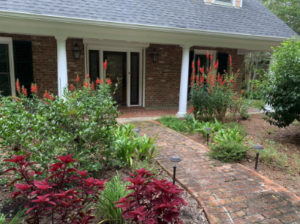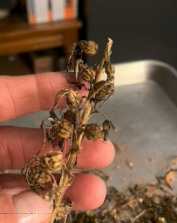Lobelia cardinalis, Cardinal flower, is one of the most impressive and striking native plants for your late summer garden. This short-lived perennial plant occurs naturally in moist locations, along stream banks, swamp edges, and low woods. In our gardens, they are easily grown in average moist garden beds, but 
are also the ultimate rain garden plant. In nature, they are usually found in somewhat shaded situations. In gardens, they seem to be able to handle quite a lot of sun as long as the soil is kept moist enough. One of the most fascinating things about our native plants is how they can be synched so precisely with the wildlife that uses them (not so with non- natives from other parts of the globe.) In this case, the ultra- rich, super-vivid red flowers of this plant appear in late summer, from July to October, on elongated 2-5 foot spikes. These plants in bloom are absolutely showstopping…for people AND our migrating hummingbirds.
 Cardinal flower is a plant of highly disturbed areas. In nature, these disturbances can be caused by river or stream flooding, animal grazing, trees toppling…. situations that expose earth to the fine seeds of cardinal flower and allow them to germinate. For that reason, these are plants that “move around,” are rarely in the exact same place for more than a few seasons and rarely live past a few seasons in one exact spot. In our gardens, we can account for that and be sure to always have Cardinal flower in our gardens by replanting new plants now and again and/or creating small, disturbed conditions and exposed areas for Cardinal flower seeds to take hold. If you have a large property, taking seed from the plant and scattering it here and there in places where it is likely to be happy can be rewarding too.
Cardinal flower is a plant of highly disturbed areas. In nature, these disturbances can be caused by river or stream flooding, animal grazing, trees toppling…. situations that expose earth to the fine seeds of cardinal flower and allow them to germinate. For that reason, these are plants that “move around,” are rarely in the exact same place for more than a few seasons and rarely live past a few seasons in one exact spot. In our gardens, we can account for that and be sure to always have Cardinal flower in our gardens by replanting new plants now and again and/or creating small, disturbed conditions and exposed areas for Cardinal flower seeds to take hold. If you have a large property, taking seed from the plant and scattering it here and there in places where it is likely to be happy can be rewarding too.
Cardinal flowers make lots of very fine seeds, about the size of granulated salt. The  spot on the upright stalk where each flower bloomed becomes a pod full of seeds. It is very important for the seeds to be mature and the stalk dry when you collect it. Because the plant blooms from the bottom to top of the stalk, often the top pods are still green while the bottoms have turned brown. Luckily, the plant holds itself upright and the pouches hold their content of seed without spilling while you wait for the entire stalk to dry. When ready, cut the stalk(s) and place in a large paper bag to bring inside for more drying time. At some point (this was a nice January task for me), the stalks can be pulled out onto a large tray and turned upside down.
spot on the upright stalk where each flower bloomed becomes a pod full of seeds. It is very important for the seeds to be mature and the stalk dry when you collect it. Because the plant blooms from the bottom to top of the stalk, often the top pods are still green while the bottoms have turned brown. Luckily, the plant holds itself upright and the pouches hold their content of seed without spilling while you wait for the entire stalk to dry. When ready, cut the stalk(s) and place in a large paper bag to bring inside for more drying time. At some point (this was a nice January task for me), the stalks can be pulled out onto a large tray and turned upside down.  Many of the seeds will spill out of the dried pod, then the pods can be
Many of the seeds will spill out of the dried pod, then the pods can be
crushed to release the rest. From here, it is fairly easy to scrape away most of the chaff and package up your seeds. Bam! As general rule, you can wild sow seeds at the general time of year when nature would have done so herself, so you can fling around Lobelia cardinalis seeds all winter long. I have sown them in trays and in the wild most months of the year, so don’t overthink it. The important thing is to get those seeds out there. Don’t “save” your seeds. Plant them. You’ll have even more next year!
